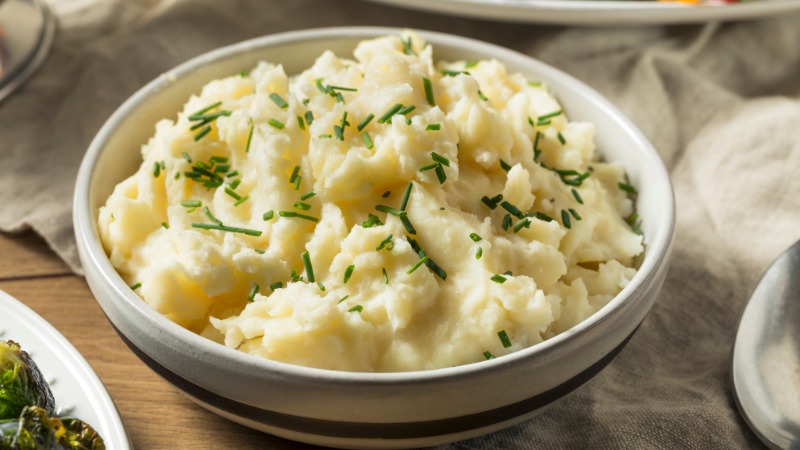This post is for informational purposes only and should not be used in place of the advice of a medical professional. When managing a swallowing disorder in older adults, it’s crucial to consult with a healthcare provider or a speech-language pathologist who can guide you in safely incorporating delicious soft foods into your diet.
Swallowing issues, known medically as dysphagia, can be a challenging condition, especially for older adults. This condition can make it challenging to swallow and may increase the risk of aspiration pneumonia due to food entering the respiratory tract instead of the stomach. It requires careful consideration of diet and food preparation to ensure safety and adequate nutrition. Swallowing difficulties can stem from various health conditions, and navigating these can seem daunting.
However, adapting to a dysphagia diet doesn’t mean sacrificing enjoyment or nutrition. By incorporating softer foods such as cottage cheese, well-cooked green beans, or mashed sweet potatoes, you can maintain a balanced diet that meets your caloric needs and appeals to your taste buds. In this post, Soft Foods for Seniors with Swallowing Issues, we’ll explore foods recommended for dysphagia, as well as, understanding the condition and much more.
Key Takeaways:
- Dysphagia requires a diet that is both safe to consume and nutritionally complete.
- It is possible to blend taste and nutrition by incorporating a variety of soft meals and snacks.
- Consultation with medical professionals is crucial for personalizing a dysphagia-friendly diet plan.
Video: Soft Foods for Seniors with Swallowing Issues
Nutritional Considerations

As seniors face challenges with swallowing, known as dysphagia, maintaining a nutrient-rich diet is crucial. This section guides you through the essential aspects of good nutrition, the risks of malnutrition, and balancing health with an appropriate diet.
Good nutrition is vital for older adults, especially when complicated by swallowing difficulties that can lead to reduced food intake. A diet rich in nutrients is essential to maintain a healthy weight and support overall well-being. Incorporating a variety of food groups can help ensure adequate intake of essential vitamins and minerals.
For those with dysphagia, transitioning to a dysphagia diet can help ensure good nutrition while avoiding hard foods that are difficult to chew and swallow. This specialized diet, also known as a mechanical diet, is a great way to include a variety of food groups while maintaining a balanced diet.
When creating meals, choosing foods that are easy to swallow is crucial, but they also need to provide good nutrition. Dairy products like soft cheeses and ice cream can offer both calcium and a sweet treat, while a hearty vegetable soup blends multiple food groups into a soft consistency that’s easier to consume.
Foods like soft cheeses, mashed potatoes, and well-cooked green beans offer both nutritional value and a soft consistency. Sweet options like a dollop of maple syrup or brown sugar on soft fruit can keep your taste buds satisfied.
Good options for protein include finely ground meat mixed with gravy or sauce, or soft food recipes like tuna salad with light mayonnaise.
Avoiding raw vegetables and raw fruits can prevent discomfort and medical conditions like blockages. However, by using a food processor to create pureed foods, virtually any vegetable or fruit can be included in a healthy diet that maintains a healthy weight. It’s always a good idea to get creative with your meals and consult with your healthcare team for follow-up tests and dietary adjustments.
Creating a Dysphagia-Friendly Diet
When tailoring a diet for those with swallowing difficulties, it’s essential to consider the levels of diet modification, ensuring adequate hydration, texture consistency, safe swallowing practices, and incorporating nutrient-dense foods to maintain good nutrition.
Dysphagia Diet Levels
National Dysphagia Diet (NDD) and International Dysphagia Diet Standardisation Initiative (IDDSI) provide frameworks for categorizing foods based on their consistency and the abilities of the person with dysphagia. The levels range from pureed foods, which are smooth and homogeneous, to regular foods that are of typical texture. Your healthcare provider or a speech-language pathologist can help determine the appropriate level for your specific needs.
Hydration and Dysphagia
Dehydration is a risk if you have dysphagia, but thickened liquids offer a solution. Beverages should meet the correct viscosity or thickness to prevent choking or aspiration. Cold foods such as ice cream can also be hydrating while offering a comforting, soft consistency. Be sure fluids are sipped throughout the day to maintain hydration. However, it is important to avoid thin liquids that can increase the risk of aspiration if swallowing reflexes are compromised.
Consistency and Food Texture
A dysphagia diet often includes foods like cottage cheese, sweet potatoes, and well-cooked green beans. You should avoid hard foods, raw vegetables, and fresh fruits that require more chewing. Utilizing blenders or food processors helps create the right texture, turning regular meals into softer foods, such as turning solid food like chicken into a fine, mechanical soft diet suitable for your condition.
Recommended Soft Foods

When selecting soft foods for seniors, especially for those on a dysphagia diet, it’s crucial to ensure that these alternatives provide good nutrition without compromising on safety. Specific textures can help prevent issues such as aspiration pneumonia and make eating easier for those with dental problems or other medical conditions.
Fruits and Vegetables
Fruits:
- Soft fruits: Perfect for their ease of consumption, options like banana, avocado, and mashed sweet potatoes provide vital nutrients.
- Applesauce: An ideal substitute for raw fruits, applesauce can be a sweet treat that’s easy to swallow.
- Fruit juice: If whole fruits pose a risk, opting for natural fruit juices is a good way to maintain fruit intake.
Vegetables:
- Steamed vegetables: Vegetables like carrots and green beans can be steamed to a soft consistency, which is a great alternative to raw vegetables.
- Vegetable soup: A warm bowl of vegetable soup provides comfort and nutrition, especially when blended for a smoother texture.
Protein Sources
- Eggs: Scrambled eggs or soft-boiled eggs are a great choice due to their versatility and rich protein content.
- Fish: Flaky fish such as salmon or tuna can be served as a delicious soft dish like tuna salad or with sauces that add moisture and extra flavor.
- Ground meat: Meatballs or patties with a soft consistency can be made from ground meat and mixed with gravy or tomato sauce to ensure they’re easier to chew and swallow.
Dairy Products and Alternatives
- Cottage cheese: This dairy product is a great way to get calcium and protein into the diet. Its texture makes it perfect for those on a mechanical soft diet.
- Yogurt: Full of good bacteria and available in various flavors, yogurt can add variety to a soft food diet while meeting caloric needs.
- Soft cheeses: Cheeses that have a naturally soft texture are easier to consume and can add a satisfying taste to soft meals.
Grains and Starchy Foods
- Oatmeal: With the option of adding brown sugar or maple syrup, oatmeal is a comforting starch that’s also a source of healthy fibers.
- Rice pudding: As a delicious soft food, rice pudding can be a sweet treat that also provides energy.
- Polenta or quinoa: These grains can be cooked to a soft consistency, making them gentle on the mouth and throat and a good source of vital nutrients.
Adapting Meals for Enjoyment and Variety
When adapting meals for seniors with swallowing issues, the focus should be on maintaining a balanced diet that provides good nutrition while ensuring the safety and pleasure of eating. However, it’s about making soft foods not just necessary but enjoyable, with a variety of tastes and textures that meet individual needs.
Flavor Enhancements and Seasonings
To keep soft meals appealing, consider incorporating a range of flavor enhancements to cater to your taste buds. Adding a sprinkle of brown sugar or a drizzle of maple syrup can bring a sweet treat element to oatmeal or pureed fruits. For savory dishes, a dollop of sour cream or a bit of cheese sauce can add both extra flavor and calories, essential for maintaining a healthy weight. Herbs and spices can be a good way to season softer foods without adding hard particles that can be difficult to swallow.
Culinary Techniques
The right culinary techniques can transform regular foods into delicious soft foods. Cooking methods like steaming or slow-cooking can soften vegetables like sweet potatoes and green beans to a perfect consistency. Using a food processor can evenly puree or mince foods, making them safer and easier to consume for those on a mechanical soft diet. Even foods typically hard to chew, such as meats, can be enjoyed as ground meat or part of a well-balanced vegetable soup.
Soft Food Recipes
Finding soft food recipes that cater to good health while being appealing is good news for those on a dysphagia diet or with oral health issues. Mashed potatoes enriched with olive oil or butter offer healthy fats and a comforting flavor. French toast soaked in egg and milk makes a soft and nutritious breakfast option. For a nourishing lunch or dinner, a tuna salad with finely chopped ingredients and extra protein from soft cheeses can be both satisfying and easy to consume. Exploring various soft fruit combinations for pureed foods is a great way to include essential vitamins like vitamin D in a healthy diet without the need to chew hard foods.
Remember, always consult with a healthcare provider or a speech-language pathologist when making significant changes to a diet for those with medical conditions and swallowing issues.
Special Considerations
When creating meals for seniors with swallowing issues, consider the following vital aspects to ensure safety, good nutrition, and meal enjoyment.
Dental and Oral Health
Oral health issues such as tooth loss or dental problems can greatly affect your ability to chew food. To support dental health and manage these issues, opt for soft foods like mashed potatoes or soft cheeses which are easier on the teeth and gums. Remember, dry mouth can also impact chewing and should be managed with the guidance of a healthcare provider.
Managing Aspiration Risks
Aspiration pneumonia is a serious condition that can occur if food enters the lungs. It’s crucial to avoid thin liquids and hard foods that can increase the risk of coughing or gagging. Discuss with a healthcare provider or speech-language pathologist about a dysphagia diet that is safe and includes options like thickened vegetable soup or pureed foods to minimize risks.
Safe Swallowing Techniques
Safe swallowing techniques are crucial. Always eat sitting up and take small, manageable bites. Chew food thoroughly if able, and follow the advice of medical professionals for individualized swallowing methods. Frequent, smaller meals can reduce the stress of eating and the risk of aspiration pneumonia.
Monitoring for Respiratory Issues
Regular monitoring for signs of aspiration pneumonia is essential. This condition can arise when food, liquid, or saliva is inhaled into the lungs, leading to pneumonia. If you experience symptoms like chest pain, coughing, or fever, contact your healthcare provider promptly.
Collaborative Care Approach
When managing swallowing difficulties in older adults, a collaborative care approach ensures that all aspects of nutrition and mealtime support are addressed effectively.
Role of Healthcare Professionals
Your healthcare team, including doctors, nurses, and speech-language pathologists, plays a crucial role in diagnosing and managing swallowing issues like oropharyngeal dysphagia. They assess your ability to chew food properly and recommend safe swallowing practices. Caregivers are trained to prepare soft meals that prevent aspiration pneumonia, a serious condition associated with swallowing difficulties. The use of mechanical soft diets or puréed food can be crucial to maintain a balanced diet, ensuring you receive adequate nutrition.
- Dieticians and doctors adapt meal plans to include delicious soft foods tailored to your caloric needs, keeping in mind the need for healthy fats, vitamin D, and other dietary requirements.
- Speech-language pathologists are responsible for teaching safe swallowing techniques and may recommend following foods with a soft consistency.
Communicating with a Nutritionist or Dietitian
Discussing your diet with a nutritionist or dietitian is essential. They can help you design a diet that includes a variety of healthy foods to maintain a healthy weight and achieve good health.
- Nutritionists guide you in selecting softer foods, like cottage cheese, mashed potatoes, and tuna salad, which are easier to swallow.
- They often recommend soft fruit, cooked green beans, and soft cheeses to ensure good nutrition.
- Seeking advice on using a food processor for preparing soft food recipes with various fruits and vegetable soup is a good idea to add extra flavor and nutrition.
In communicating with these professionals, express your preferences for favorite foods and extra protein sources like ground meat or smooth peanut butter. Your feedback helps adjust food intake, ensuring you enjoy large meals or small frequent meals according to your individual needs. Together with your healthcare provider, you can maintain a healthy diet filled with nutritious and palate-pleasing options.
FAQs
Can you suggest cooking techniques for creating soft-textured foods that are easy to swallow?
To create soft-textured foods, steaming or stewing fruits and vegetables until they are tender is recommended. Meat can be slow-cooked to a soft consistency and mashed or pureed using a food processor, if necessary.
Which foods should be avoided for those suffering from dysphagia to prevent choking?
Foods that are hard, sticky, or contain seeds and skins like raw vegetables, nuts, and hard-boiled eggs should be avoided. Thin liquids, such as water or tea, may also need to be thickened to reduce the risk of aspiration.
How can you modify traditional meals to accommodate the dietary needs of the elderly with swallowing issues?
Traditional meals can be adapted by finely chopping or blending solid food components to make them safer to eat. Techniques such as adding cheese sauce or chicken broth can also make regular foods softer and easier to swallow.
Additional Reading
Conclusion
Managing your dietary needs can sometimes be challenging, especially if you’re facing swallowing difficulties due to medical conditions like dysphagia. Prioritizing good nutrition is crucial, and incorporating softer foods into your diet is a great way to maintain a balanced diet while dealing with these challenges.
When selecting soft foods for seniors with swallowing issues consider looking for soft meals rich in healthy fats such as avocado and olive oil, which can also bring extra flavor to your dishes. Focus on soft fruits like bananas, which are easier on the throat and perfect choices for maintaining good health. Cottage cheese and soft cheeses are not only rich in nutrients like vitamin D and calcium but also have a soft consistency that’s ideal for a dysphagia diet.
When preparing vegetables, steamed green beans or a smooth vegetable soup can be good options over raw vegetables which are often too hard. For proteins, choose ground meat that can be easily incorporated into tuna salad or mixed with cheese sauce for extra protein.
Engage with healthcare professionals to help manage food intake and ensure you are getting a healthy diet that accounts for your individual needs and caloric needs. They can guide you on how to properly chew food, modify solid food textures, and prevent complications like aspiration pneumonia. Maintaining oral health issues and committing to regular follow-up tests and adjustments to your diet are pivotal steps in safeguarding your well-being.
Have you tried any soft food recipes that you enjoy? Please share below.










